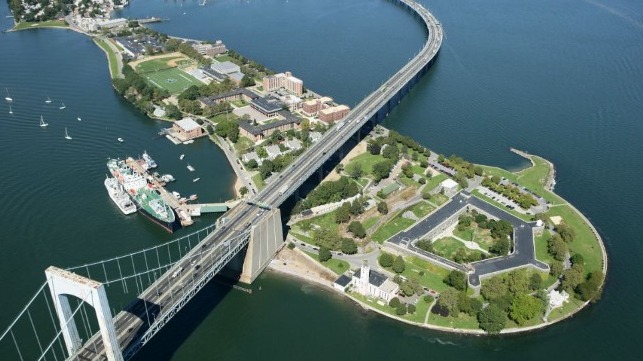Blue-Ribbon Panel at SUNY Maritime's "Blue Highway" Conference

Highways, roads, and bridges in and around the New York metro area are increasingly clogged with bumper-to-bumper commercial truck and commuter traffic. That’s not news to anyone who has driven I-95 along the U.S. East Coast. The congestion increases air pollution— leading to increased health risks—and slows the flow of people, commerce, and goods to a crawl throughout the region.
The New York City Economic Development Corporation (NYCEDC) estimates that truck congestion and delays cost $862 million in 2017, and estimated that the cost would rise by 31 percent to $1.1 billion by 2045. NYEDC is investing $100 million in infrastructure to promote and establish waterborne transportation alternatives in and around the region.
On September 27, 2018, SUNY Maritime College and the Maritime Industry Museum at Fort Schuyler will host America’s Blue Highway, a one-day conference that will bring together key players to discuss ways to move cargo transport off land and onto the water, thereby reducing road congestion and air pollution.
The Honorable Mark H. “Buz” Buzby, Administrator of the U.S. Maritime Administration, will keynote the event.
Other nations and regions around the world are increasingly seeking to move cargo traffic off the roads and onto ships. These marine highways are developing to enable and sustain what is called short-sea shipping, where freight is carried over water for shorter distances than traditional shipping operations.
“For marine highways to be successful in this country, we need to raise awareness of the advantages short-sea shipping has to offer,” said Capt. Eric Johansson, distinguished professor of Marine Transportation at Maritime. “This conference is an opportunity for urban and regional planners, terminal operators, educational institutions and labor organizations to learn how to integrate marine highways into their policies and plans.”
The Maritime Administration, a branch of the U.S. Department of Transportation, has designated 25 marine highway routes around the country. One of them includes New York City, and the city government is initiating a marine highway solution to export municipal waste and other cargo through the Red Hook Container Terminal in Brooklyn.
The conference will feature a variety of speakers from around the region and the maritime industry:
Rear Adm. Michael Alfultis, SUNY Maritime College president
Mark H. Buzby, administrator of the Maritime Administration
Cole Cosgrove, vice president of marine operations for Crowley Liner Services
Scott Davies, director of ports and waterways planning for MARAD
Capt. Jeffrey Flumignan, director of MARAD's North Atlantic gateway office
Andrew Genn, strategic vice president of PortNYC and asset management for NYCEDC
Robert Kunkel, owner and principal of Harbor Harvest
Dennis Lombardi, Romark Logistics
Matthew Kwatinetz, executive vice president of PortNYC and asset management for NYCEDC
Buckley McAllister, president of McAllister Towing
Kyle McAvoy, Robson Forensic
Jim Pelliccio, CEO and president of Port Newark Container Terminal
Bethann Rooney, assistant director of Port Authority of NY/NJ
Mick Stamatis, president of Red Hook Container Terminal
Capt. Jack Sullivan, vice president of vessel operations and engineering at Matson Navigation Company
Richard Teubner, vice president of SEACOR
Derek Veenhof, executive vice president of asset management for Covanta
Ed Whitmore, president and CEO of Norfolk Tug Co.
Matt Woodruff, president of the American Maritime Partnership
Ed Zimny, president and CEO of Seabury Capital
The opinions expressed herein are the author's and not necessarily those of The Maritime Executive.
